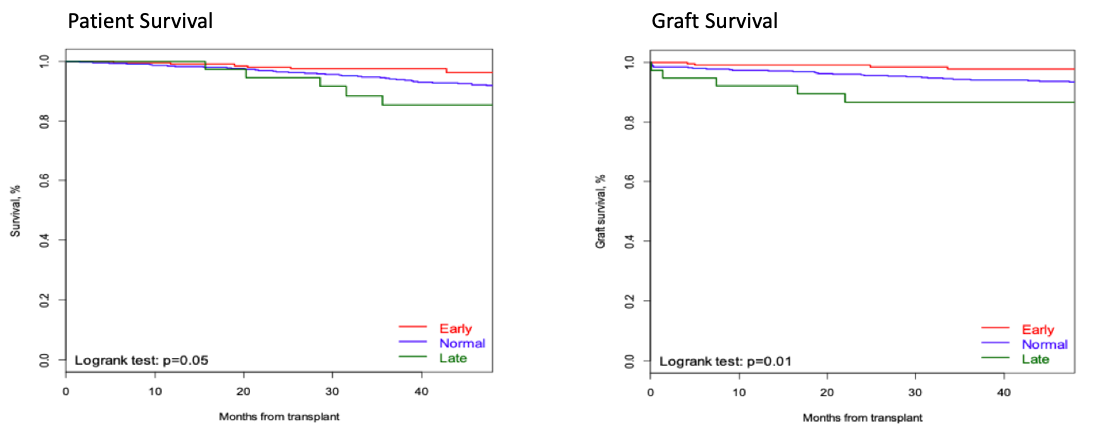Outcomes and Health Care Utilization after Early Hospital Dismissal in Kidney Transplantation: An Analysis of 1001 Consecutive Cases
1Transplant Surgery, Mayo Clinic, Phoenix, AZ, 2Kern Center for the Science of Health Care Delivery, Mayo Clinic, Phoenix, AZ, 3Department of Nephrology, Mayo Clinic, Phoenix, AZ
Meeting: 2020 American Transplant Congress
Abstract number: 177
Keywords: Kidney, Kidney transplantation, Outcome, Resource utilization
Session Information
Session Name: Quality Assurance Process Improvement & Regulatory Issues I
Session Type: Oral Abstract Session
Date: Saturday, May 30, 2020
Session Time: 3:15pm-4:45pm
 Presentation Time: 4:15pm-4:27pm
Presentation Time: 4:15pm-4:27pm
Location: Virtual
*Purpose: Perioperative care after kidney transplantation has improved with reduction in length of operative stay to as low as two days, but this has an unknown effect on post-transplant health care utilization; we aimed to define this association in a cohort of 1001 consecutive kidney transplants at our center
*Methods: A prospectively-collected kidney transplant database merged with health care utilization administrative data from a single center was retrospectively reviewed from 2011 to 2015. Patients were divided into Early (<2 Days), Normal (3-5 Days) and Late (>5 Days) Dismissal.
*Results: A total of 1001 patients were identified. Patients were divided into Early (19.8%), Normal (79.4%) and Late discharge (3.8%). Early dismissal was associated with a higher proportion of living donor transplants (Early vs. Normal vs Late: 51% vs 31.4% vs 18.4%, p<0.001). The Early discharge group had lower delayed graft function (Early vs Normal vs Late: 19.2% vs 32% vs 73.7, p=0.001). There was no difference in readmission rate or Emergency Room visits at 30 and 90 days. GFR at 12 months was similar and biopsy proven rejection did not differ. Early and Normal discharge patients had improved graft and patient survival when compared to Late discharge patients (p=0.05). Our risk adjusted models showed no difference in readmission, patient and graft survival.
*Conclusions: Discharging patients two days after kidney transplant is feasible. It does not increase hospital utilizations and provides similar patient and graft survival when compared to patients that are discharged later.
| 30 Day Risk Adjusted Readmission OR (95% CI) | 90 Day Risk Adjusted Readmission OR (95% CI) | 1 yr Risk Adjusted Patient Survival HR (95% CI) | 1 yr Risk Adjusted Graft Survival HR (95% CI) | |
| Early Discharge (< 2 Days) | 1.07 (0.73-1.57) | 0.99 (0.70-1.40) | 0.63 (0.27-1.48) | 0.36 (0.13-1.01) |
| Late Discharge (>5 Days) | 0.60 (0.27-1.35) | 1.04 (0.53-2.04) | 1.65 (0.66-4.14) | 2.13 (0.84-5.36) |
| NormalDischarge (3-5 Days) | 1 | 1 | 1 | 1 |
To cite this abstract in AMA style:
Calderon E, Chang Y, Chang JM, Velazco C, Giorgakis E, Moss AA, Khamash H, Heilman R, Reddy KS, Mathur AK. Outcomes and Health Care Utilization after Early Hospital Dismissal in Kidney Transplantation: An Analysis of 1001 Consecutive Cases [abstract]. Am J Transplant. 2020; 20 (suppl 3). https://atcmeetingabstracts.com/abstract/outcomes-and-health-care-utilization-after-early-hospital-dismissal-in-kidney-transplantation-an-analysis-of-1001-consecutive-cases/. Accessed December 26, 2025.« Back to 2020 American Transplant Congress

